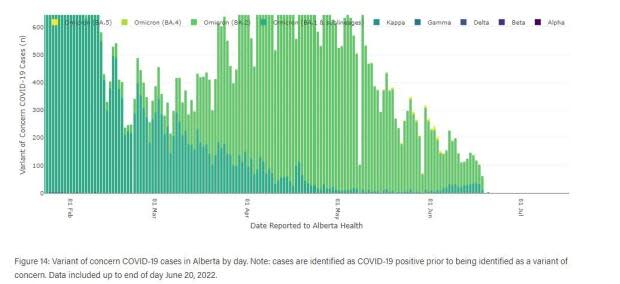Is Alberta in for a summer COVID-19 surge? Scientists say an uptick likely within months

A B.C. scientist is warning that while Alberta's sixth COVID-19 wave is receding, the province could be in for another COVID-19 surge this summer.
Alberta's COVID indicators, including hospitalizations, deaths, and positivity rates all continue to drop. But, at the same time, some more transmissible Omicron subvariants are showing signs of growing.
Canada's chief public health officer, Dr. Theresa Tam, noted in a tweet Friday that the overall proportion of BA.4 and BA.5 cases is rising in the country.
And Sarah Otto, who tracks provincial pandemic trends as a member of an independent B.C. modelling group, said the subvariants — while still "smouldering" in low numbers — are doing what they've done at the start of previous waves.
"The [overall] cases look like they're declining, but that's a mirage because the cases of BA.4 and BA.5 are rising," said Otto, who also teaches at the University of British Columbia.
"I predict in the next couple of weeks, [Alberta is] going to start seeing an uptick due to these new variants, so we should be seeing a new wave in July and August. How high will that wave be? It's too early to tell."

According to Otto, the trends are difficult to tease out because of the way the province reports variant cases.
Alberta Health's publicly available data shows a small and recent uptick in BA.1 cases (BA.1 drove the fifth wave, which began around Christmas and was eventually replaced by BA.2).
The small number of daily BA.4 and BA.5 cases that had been showing up dropped off around the same time.
According to Otto, when BA.4 and BA.5 cases are initially screened, they can look like BA.1 cases because they show the same mutation.
And she believes once these cases go for full genome sequencing, a process that can take several weeks, they'll be reclassified as BA.4 and BA.5.
"If you look at the sequencing that has been done in Alberta and elsewhere in Canada recently, almost all of those uncertain categories are BA.4 and BA.5," she said.
"[I think] the recent uptick in that category is due to BA.4 and BA.5 spreading, not BA.1 spreading. BA.1 was on its way out."

Alberta Health would only say positive cases continue to be screened for variants of concern, and hundreds of samples are sent for full genome sequencing each week.
"There are a small number of cases in which the screening test may show the virus as a BA.1 but subsequently be re-classified following full genome sequencing," spokesperson Lisa Glover said in a statement emailed to CBC News.
"This would be updated as data online is updated each week. The intent of surveillance is not to characterize every virus from every case, but rather to keep a close eye on trends for how the virus continues to evolve over time."

Calgary-based infectious disease expert Craig Jenne said it is possible some of the new subvariant cases are initially being counted as BA.1, and will be reclassified after further testing, because they're all closely related.
"What we are losing is a little bit of granularity on where particular viral variants are spreading, how quickly they're spreading," said Jenne, an associate professor in the department of microbiology, immunology and infectious diseases at the University of Calgary.
"And without that information, it's always a little more difficult to prepare ourselves to respond if needed or to be able to head off problems while they're still small, instead of waiting for these things to unfortunately develop into potential waves."
According to Jenne, Otto's prediction is something worth noting.
"This [modelling] group has been very close — very accurate — on the previous large waves in Alberta. So I think we should be taking some of this information to heart, that there is that potential."
He, too, expects COVID-19 cases to rise again, in either late summer or early fall.
"With these subvariants slowly becoming the dominant strain in the community, as immunity wanes, we will see cases go up. We will potentially see another wave. But the big question is, how big is that wave … and secondly, how disconnected that wave of new cases is from hospitalizations."
The key moving ahead, according to Jenne, is vaccination, including booster doses. And he believes its time for Alberta to consider expanding eligibility for fourth doses.
"As we move to later summer early fall … we're going to absolutely going to need to get that protection out if we want to avoid rising hospitalization with rising cases."


